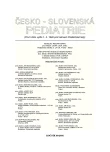-
Medical journals
- Career
The Role of Plasma Procalcitonin and Other Inflammatory Markers as Identifiers of Bacterial Infections in Children with Solid Tumor
Authors: J. Kruseová 1; M. Průcha 2; M. Dostál 3; E. Pindurová 1; I. Lišková 1; O. Nyč 4; D. Sumerauer 1; J. Němcová 1; J. Starý 1
Authors‘ workplace: Klinika dětské hematologie a onkologie 2. LF UK a FNM, Praha přednosta prof. MUDr. J. Starý, DrSc. 1; Oddělení klinické biochemie, hematologie a imunologie, Nemocnice na Homolce, Praha přednosta prof. MUDr. J. Hyánek, DrSc. 2; Ústav experimentální medicíny, Praha přednostka prof. MUDr. E. Syková, DrSc. 3; Ústav klinické mikrobiologie 2. LF UK a FNM, Praha přednosta MUDr. O. Nyč 4
Published in: Čes-slov Pediat 2005; 60 (4): 206-212.
Category: Original Papers
Overview
The authors evaluated the diagnostic impact of procalcitonin (PCT), C-reactive protein (CRP) blood sedimentation rate (FW), absolute neutrophil count (ANC) and absolute monocyte count (AMC) in the prediction of bacterial infection in children with febrile neutropenia.
They measured each indicator daily in 21 patients (12 boys and 9 girls) with febrile neutropenia. The first blood samples were taken when patient had fever > 38 °C before antibiotic treatment and the last sample 24 hour after antibiotic discontinuation. The period during which measurements were made ranged from five to 17 days (average 8.3 day).#Patient age:
2 years and 6 months to 24 years and 6 months (average 12 years and 1 month). The authors used nonparametrical statistical methods.#Patient diagnosis:
Ewing sarcoma 8 times, soft tissue sarcoma 7 times, osteosarcoma 3 times, CNS tumour twice and non-Hodgkin lymphoma once. Four patients had positive blood culture, six patients had local infection and eleven patients had fever of unknown origin (FUO).
Fifteen patients had leukopenia grade IV – leu<1.0x109/l and ANC<500 and six patients leu>1.0x109/l and ANC>500. Patient with bacteriemia had median CRP D (day)1 -179.4 mg/l and D2 -143.9 mg/l, median PCT D1 -0.41 ng/ml and D2 -0.47 ng/ml, patient with fever of unknown origin median CRP D1 -42.2 mg/l a D2 -78.15 mg/l and median PCT D1 -0.345 ng/ml a D2 -0.635 ng/ml. CRP had the best predictive role in distinguishing between positive blood culture and FUO. This results was not, however, statistically significant. There was no difference between FUO and local infection. Procalcitonin levels were no different among patients with FUO, local infection and positive blood culture (the group contained only patients with Gram positive bacteriemia). There was strong correlation between the number of days AMC<100 and ANC<500 and the number of days the patients had fever. Fevers resolved within 3 days the number of days with AMC<100 and ANC<500 lasted only 0.9 days (0–4 d) and 2.87 days (2–4 d), fevers lasted more than three days the number of days with AMC<100 and ANC<500 were 3.3 days (0–8 d) and 5.14 days (1–9 d).
This paper also contains a short summary of literature setting out the diagnostic impact of various infection markers in children with febrile neutropenia.Key words:
procalcitonin, inflammation markers, febrile neutropenia, children, literature summary
Labels
Neonatology Paediatrics General practitioner for children and adolescents
Article was published inCzech-Slovak Pediatrics

2005 Issue 4-
All articles in this issue
- The Deficiency of Immunoregulatory T Cells in Children with Diabetes Mellitus
- Importance of Molecular Genetic Examination for Diagnostics of Wilson Disease
- Evaluating the Risk of Development of Autoimmune Liver Diseases in Children after Liver Resection
- The Role of Plasma Procalcitonin and Other Inflammatory Markers as Identifiers of Bacterial Infections in Children with Solid Tumor
- Intentional Poisoning with Lethal Dose of Imipramine in a 14-year Boy
- Transplantation of Umbilical Blood in a 4-year Boy with Adrenoleukodystrophy Bound to Chromosome X
- X-linked Hypophosphatemic Rickets
- Autonomous Nervous System (ANS) and Possible Determination of ANS Activity in Obesity
- Children, Youth and Water-related Injuries
- Czech-Slovak Pediatrics
- Journal archive
- Current issue
- Online only
- About the journal
Most read in this issue- X-linked Hypophosphatemic Rickets
- The Role of Plasma Procalcitonin and Other Inflammatory Markers as Identifiers of Bacterial Infections in Children with Solid Tumor
- Intentional Poisoning with Lethal Dose of Imipramine in a 14-year Boy
- Importance of Molecular Genetic Examination for Diagnostics of Wilson Disease
Login#ADS_BOTTOM_SCRIPTS#Forgotten passwordEnter the email address that you registered with. We will send you instructions on how to set a new password.
- Career

